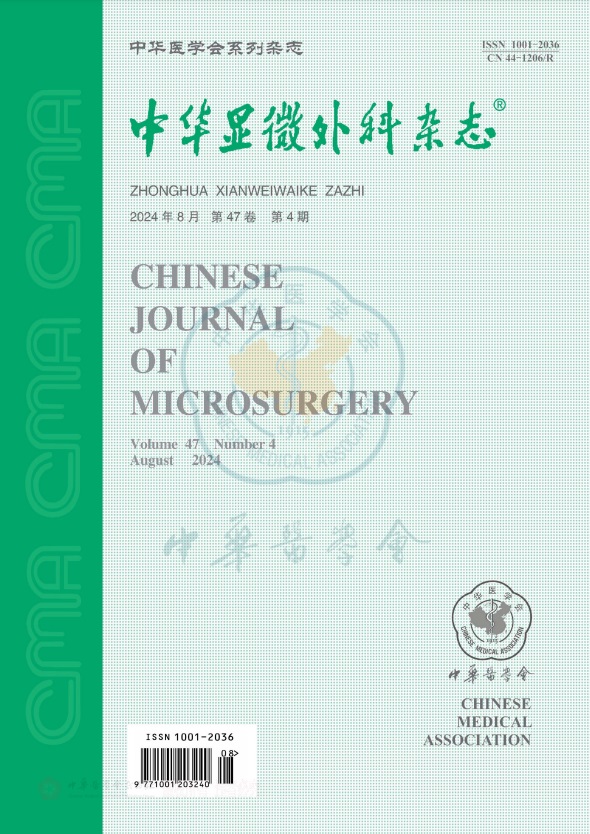Repairing dorsal complex tissue defect of finger with flaps based on superficial palmar branch of radial artery with palmaris longus tendon
引用次数: 0
Abstract
Objective To explore the clinical effects in repairing dorsal complex tissue defect of finger with the flap based on superficial palmar branch of radial artery (SPBRA) with palmaris longus tendon. Methods From May, 2011 to October, 2017, dorsal complex tissue defects of 15 fingers and thumbs in 15 patients were treated by the flaps which were based on SPBRA with palmaris longus tendon. There were 10 males and 5 females, in an average of 35.8 (19-51) years. All the defects (3 thumbs, 5 index, 2 middle and 5 ring fingers) were dorsal complex tissue defects and all had extensor tendon defects. The areas of soft tissue defect measured 2.0 cm×1.5 cm to 4.0 cm×2.0 cm. The lengths of tendon defect measured 2.0-4.0 cm. All patients received emergency surgery. The time before the surgery was 1.5-3.0 hours. The surgery time was 3.0-4.5 hours, 3.6 hours in an average. Postoperative regular follow-up. Results All of the wounds healed in stage I and all flaps survived. Texture of the flaps was soft with rosy color. No obvious swelling occurred. All the donor sites healed in stage I. The patients were followed-up for 4-18 months, 8 months in an average. The appearance and function of the repaired fingers and thumbs were satisfactory. The pain, temperature and touch sensations were good. The color of flaps was similar to the normal finger without swelling. The wear resistance of the flaps was good. Thin-line scars were in the wrist donor sites without contracture. The range of motion of active palmar flexion of the wrist was from 0° to 80° and active hyperextension was from 0° to 70°. No obvious limitation was found. Conclusion It is able to achieve a satisfactory clinical effects by using the flap that is based on SPBRA with palmaris longus tendon in repairing the dorsal complex tissue defect of hand. The advantages of the technique are that the donor site is concealed. The wound is small, and the flap is easy to be harvested and anastomosed. Key words: Superficial palmar branch of radial artery flaps; Complex tissue flaps; Palmaris longus tendons; Finger; Repair掌长肌腱桡动脉掌浅支皮瓣修复手指背侧复杂组织缺损
目的探讨掌长肌腱桡动脉掌浅支皮瓣修复手指背侧复杂组织缺损的临床效果。方法自2011年5月至2017年10月,应用掌长肌腱SPBRA皮瓣修复15例手指拇指背侧复杂组织缺损。男10例,女5例,平均年龄35.8岁(19-51岁)。所有缺损(3个拇指、5个食指、2个中指和5个无名指)均为背侧复杂组织缺损,均为伸肌腱缺损。软组织缺损面积为2.0cm×1.5cm至4.0cm×2.0cm,肌腱缺损长度为2.0-4.0cm。所有患者均接受了急诊手术。手术前1.5~3.0小时。手术时间3.0-4.5小时,平均3.6小时。术后定期随访。结果Ⅰ期创面全部愈合,皮瓣全部成活。皮瓣质地柔软,呈玫瑰色。无明显肿胀。所有供区均在I期愈合。患者随访4-18个月,平均8个月。修复后的手指和拇指的外观和功能均令人满意。疼痛、体温和触觉都很好。皮瓣的颜色与正常手指相似,没有肿胀。襟翼的耐磨性很好。手腕供区有细线疤痕,无挛缩。腕关节主动掌侧屈曲的运动范围为0°至80°,主动超伸的运动范围从0°至70°。没有发现明显的局限性。结论掌长肌腱SPBRA皮瓣修复手背侧复杂组织缺损具有良好的临床效果。该技术的优点是供体部位是隐蔽的。伤口小,皮瓣易于摘取和吻合。关键词:桡动脉掌浅支皮瓣;复杂组织瓣;掌长肌腱;手指;修理
本文章由计算机程序翻译,如有差异,请以英文原文为准。
求助全文
约1分钟内获得全文
求助全文
来源期刊
CiteScore
0.50
自引率
0.00%
发文量
6448
期刊介绍:
Chinese Journal of Microsurgery was established in 1978, the predecessor of which is Microsurgery. Chinese Journal of Microsurgery is now indexed by WPRIM, CNKI, Wanfang Data, CSCD, etc. The impact factor of the journal is 1.731 in 2017, ranking the third among all journal of comprehensive surgery.
The journal covers clinical and basic studies in field of microsurgery. Articles with clinical interest and implications will be given preference.

 求助内容:
求助内容: 应助结果提醒方式:
应助结果提醒方式:


